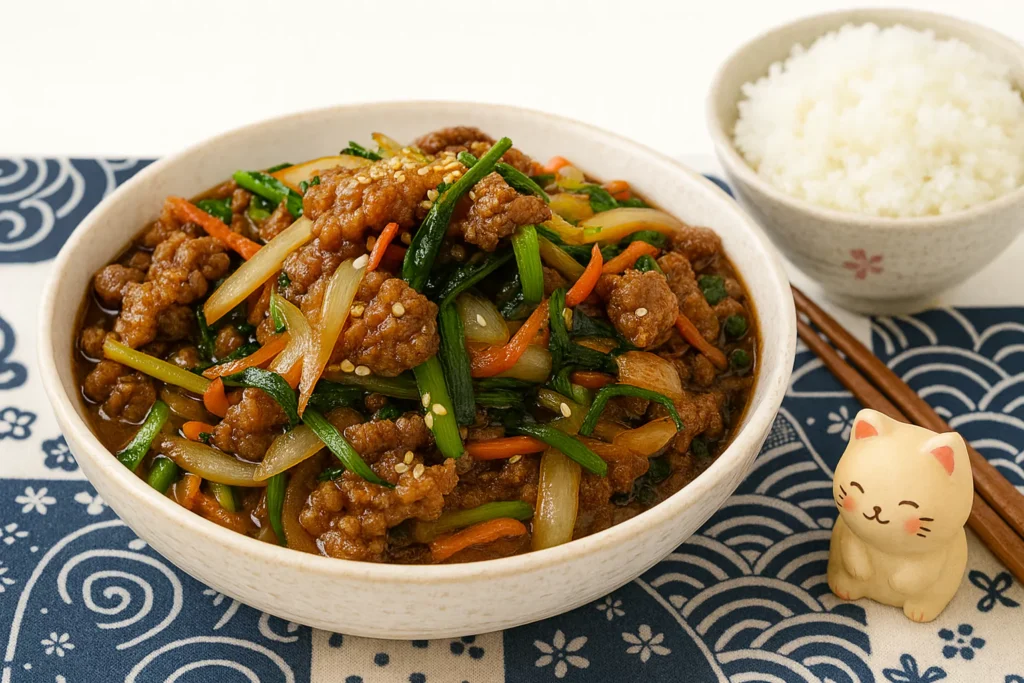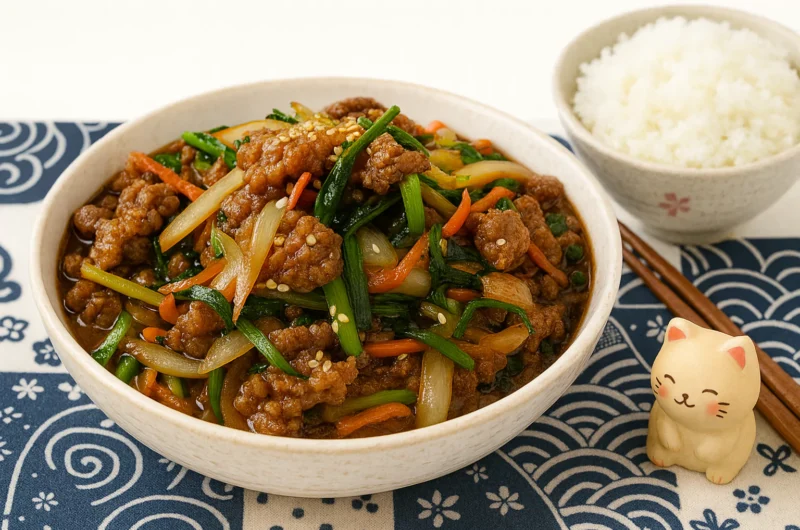Can Simple Ingredients Make an Extraordinary Dish?
When you think about cooking at home, do you imagine needing long recipes and fancy equipment? The truth is, some of the best meals are the simplest ones. Stir-fried Beef and Chives (牛肉とチャイブの炒め物) is a perfect example. It uses everyday ingredients like beef, onion, carrot, and fresh chives — yet the result is a dish bursting with flavor.
This classic stir-fry shows us how a little preparation and the right balance of seasonings can create something that tastes like restaurant food, but takes less than 30 minutes to make. It’s bold, colorful, and satisfying. So, can a quick stir-fry really become your go-to dinner recipe? Let’s dive in and find out why Stir-fried Beef and Chives is a dish you’ll want to cook again and again.
Why Choose Stir-fried Beef and Chives (牛肉とチャイブの炒め物)?
Stir-fried Beef and Chives is more than just another stir-fry. It’s a harmony of savory beef, the crisp bite of chives, and a glossy sauce that coats every piece.
- Cooking Time: 20–25 minutes.
- Difficulty Level: Beginner-friendly.
- Special Feature: The combination of tender beef and garlic-scented chives makes this dish unforgettable.

Stir-fried Beef and Chives (牛肉とチャイブの炒め物) @JapanDishes
What Is Stir-fried Beef and Chives?
In Japanese, 牛肉とチャイブの炒め物 (Gyūniku to Chaibu no Itamemono) means “beef and chives stir-fry.” At its heart, this recipe is about highlighting fresh, seasonal chives and pairing them with juicy beef. The sauce blends soy sauce, sake, oyster sauce, and a little gochujang for depth and a touch of spice.
What makes this dish unique is its balance — it’s hearty yet refreshing, flavorful yet light, and works beautifully both as a main dish or as part of a larger Japanese-style meal.
Jump to Recipe Print RecipeEssential Ingredients for Stir-fried Beef and Chives
Here’s what you need to make Stir-fried Beef and Chives (牛肉とチャイブの炒め物):
- Beef trimmings (200g): Affordable and tender when cooked quickly. Substitute with thinly sliced flank steak or sirloin if needed.
- Chives (1 bunch): The key flavor. They bring freshness and mild garlicky notes. If unavailable, try green onions or garlic shoots.
- Onion (½ piece): Adds sweetness and body.
- Carrot (2 cm piece): For crunch, color, and natural sweetness.
- Seasoning A: Sake, sesame oil, garlic paste, salt, pepper, and potato starch. These seasonings tenderize and coat the beef.
- Seasoning B: Soy sauce, sugar, sake, oyster sauce, and gochujang. Together, they form a glossy, savory-sweet sauce with a subtle kick.
- Sesame seeds: A nutty garnish that completes the dish.
Why These Ingredients Matter
The beef delivers richness, the chives provide freshness, and the sauce creates depth. Each plays a role in making Stir-fried Beef and Chives a well-rounded dish.
Step-by-Step Instructions
Follow these steps for a perfect Stir-fried Beef and Chives (牛肉とチャイブの炒め物):
Step 1: Marinate the Beef
Rub beef with sake, sesame oil, garlic, salt, and pepper. Lightly coat with potato starch. This step locks in juices and ensures tender meat.
Step 2: Prep the Vegetables
- Slice onion thinly.
- Slice carrot into matchsticks.
- Cut chives into 4 cm pieces.
Step 3: Stir-fry the Beef
Heat sesame oil in a pan over high heat. Stir-fry beef until it just starts to change color, then add onion.
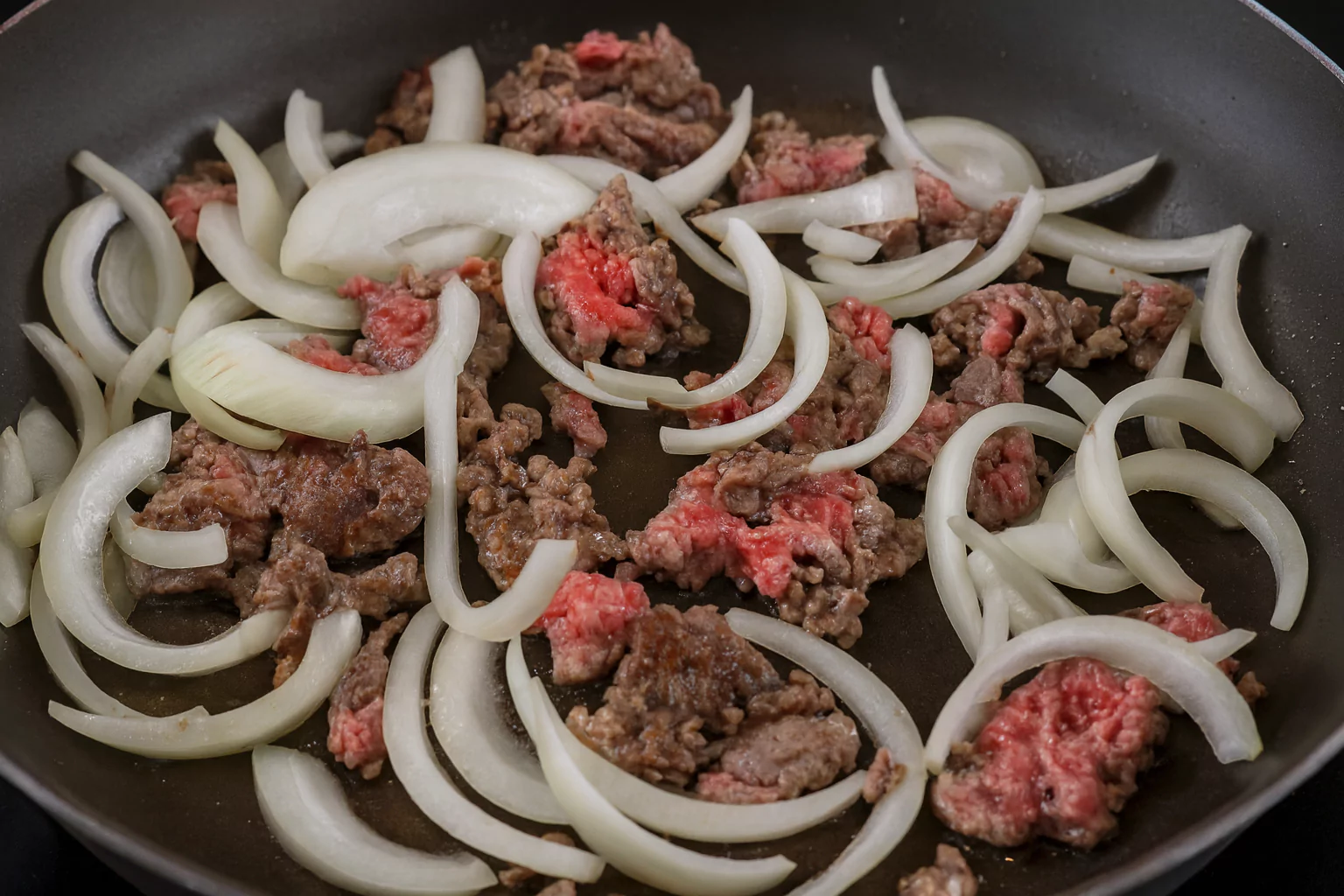
Step 4: Add Vegetables
First add carrots. Stir-fry briefly before tossing in the chives.
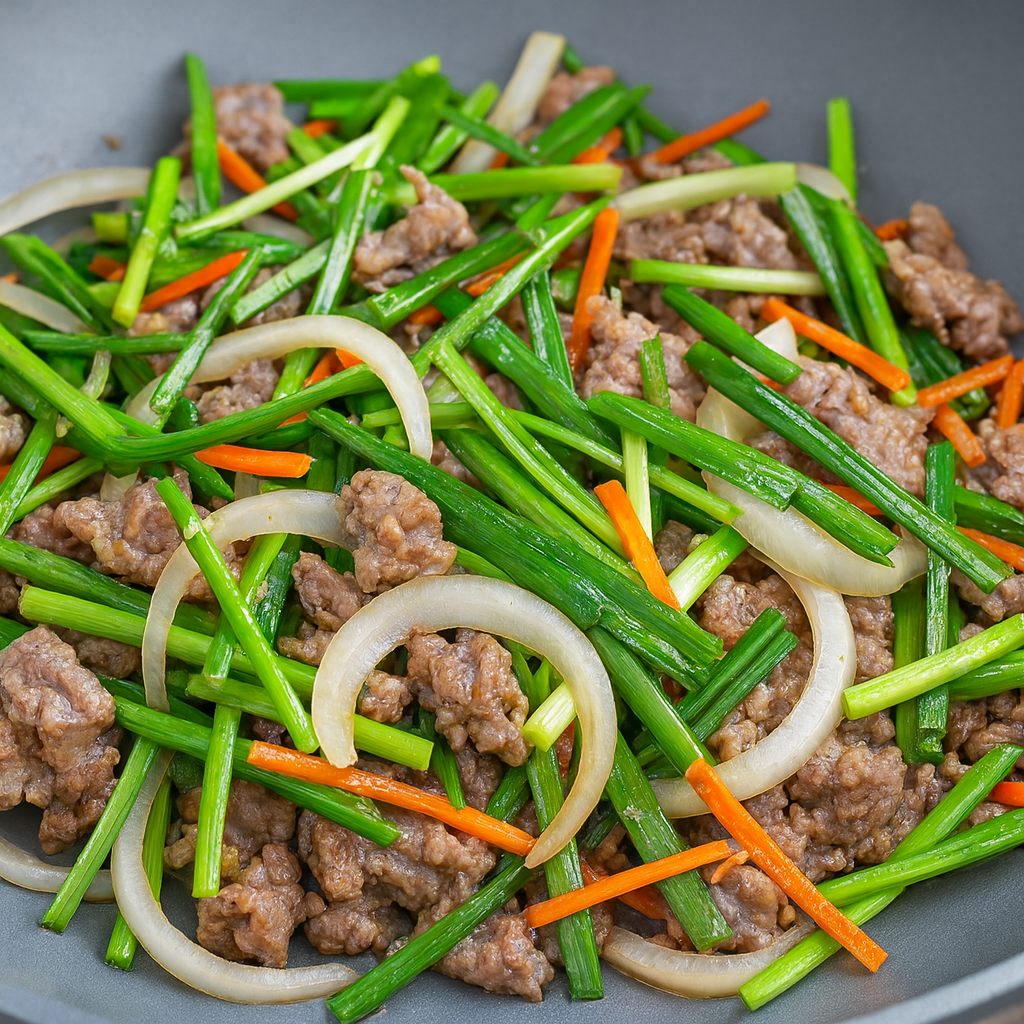
Step 5: Add the Sauce
Pour in Seasoning B (soy sauce, sugar, sake, oyster sauce, gochujang). Stir quickly so everything is coated evenly.
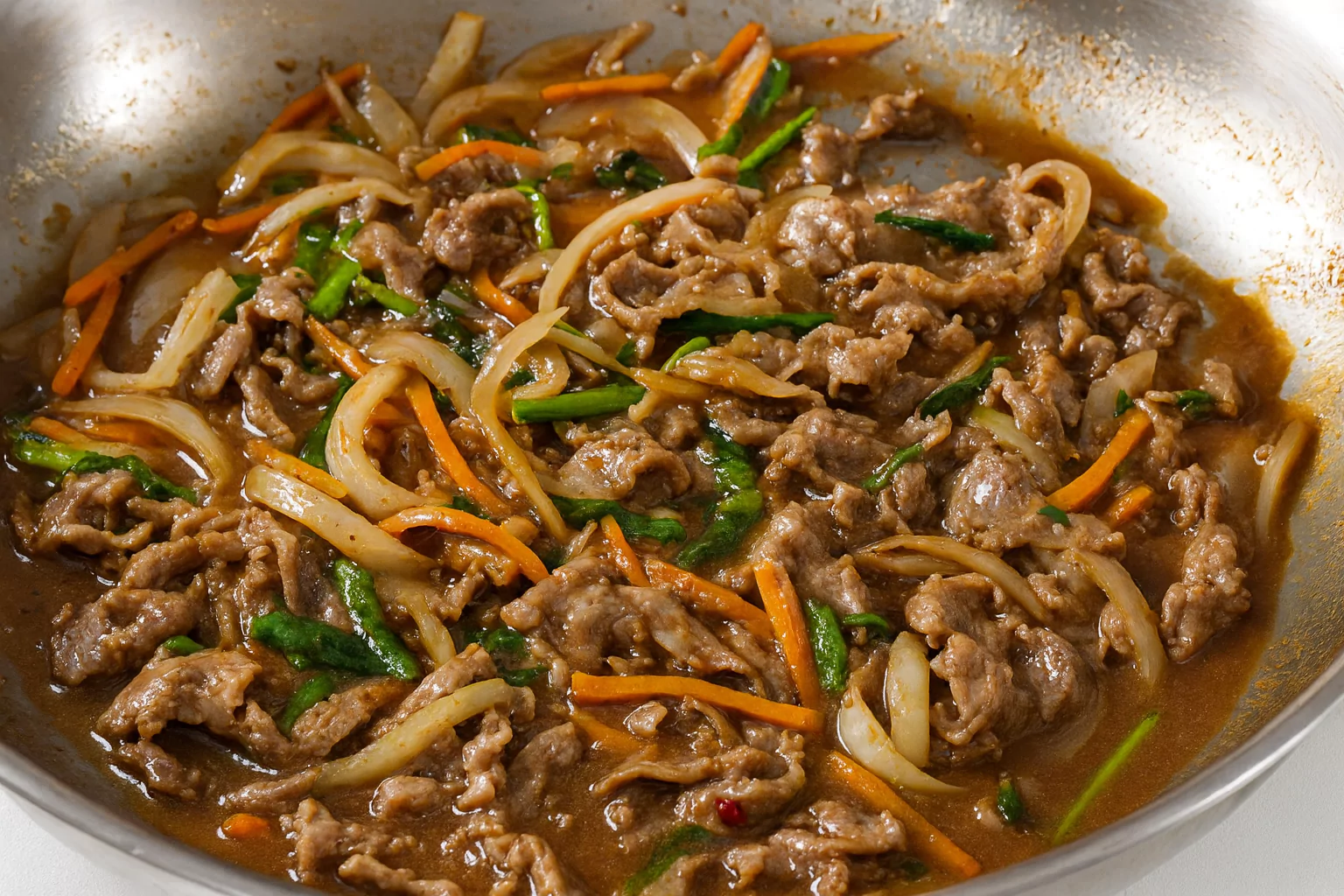
Step 6: Finish and Serve
Transfer to a dish, sprinkle with sesame seeds, and serve immediately with steamed rice.
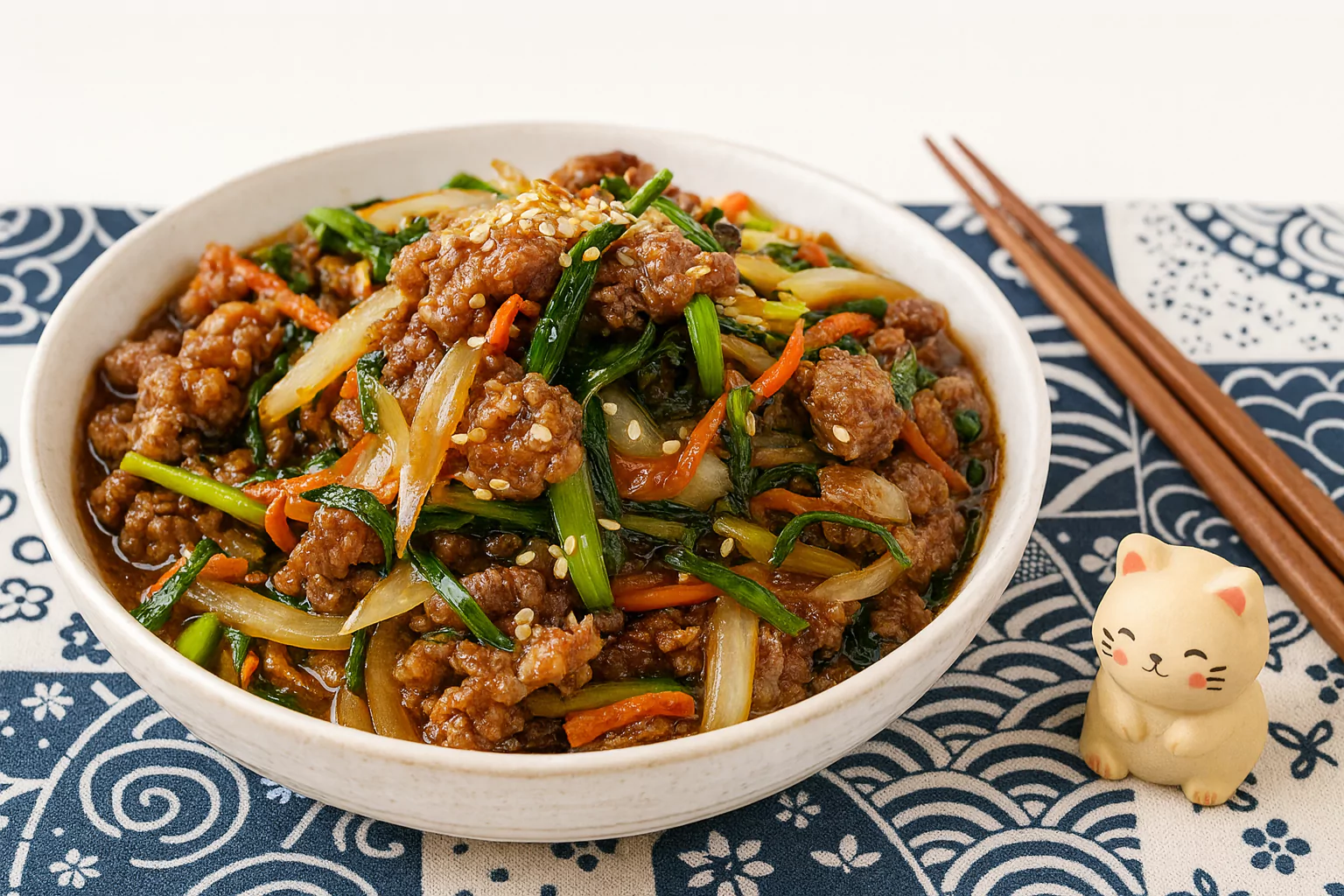
Stir-fried Beef and Chives (牛肉とチャイブの炒め物) @JapanDishes
Secrets to Success and Expert Tips
- Quick Cooking: High heat and short cooking time keep beef juicy and chives crisp.
- Even Cutting: Slice vegetables evenly so they cook at the same rate.
- Sauce Timing: Always add sauce last to avoid soggy vegetables.
- Fresh Chives: Use fresh chives for the best aroma — frozen ones lose flavor.
Mastering these small steps is the secret to making your Stir-fried Beef and Chives (牛肉とチャイブの炒め物) taste authentic and delicious.
Assembly and Presentation
How you serve Stir-fried Beef and Chives makes a difference:
- Serve it over hot steamed rice as a donburi (rice bowl).
- Use a clean white plate to highlight the green chives and orange carrots.
- Sprinkle sesame seeds generously for contrast.
For more inspiration on Japanese-style presentation and plating, you can explore other comforting dishes like Cherry Blossom Milk Pudding which pairs beautifully as a light dessert after a savory stir-fry.
Hana’s Recipe Tips
- Add a fried egg on top to turn this into a hearty one-bowl meal.
- Balance the flavors: If too salty, add a splash of water or extra vegetables.
- Make it kid-friendly: Reduce gochujang for a mild version.
Storage and Make-Ahead Tips
- Store: Keep in an airtight container in the fridge for up to 2 days.
- Reheat: Warm gently in a skillet with a spoonful of water to refresh the sauce.
- Make-ahead: Marinate beef up to 12 hours in advance for deeper flavor.
Recipe Variations
- Extra Spicy Stir-fried Beef and Chives: Add more gochujang or chili flakes.
- Vegetarian Version: Swap beef with tofu or shiitake mushrooms.
- Seasonal Greens: Replace chives with spinach or bok choy.
- Japanese Twist: Stir in miso paste for added umami.
Each version keeps the heart of Stir-fried Beef and Chives (牛肉とチャイブの炒め物) while offering new flavors.
Conclusion
Cooking doesn’t need to be complicated. Stir-fried Beef and Chives (牛肉とチャイブの炒め物) proves that with just a few ingredients, you can create something deeply satisfying. It’s fast, flexible, and packed with flavor — a dish that feels special even on the busiest nights.
Next time you’re wondering what to make for dinner, try this recipe. You’ll discover why Stir-fried Beef and Chives has become a favorite in homes where flavor and simplicity matter most.
And if you’re planning to enjoy this dish while traveling in Japan, don’t forget to check out guides like the JR Kansai Area Pass to make your trip more convenient and enjoyable.
FAQs
Q1: Can I use other cuts of beef for Stir-fried Beef and Chives?
Yes. Flank steak, sirloin, or ribeye all work well.
Q2: What if I don’t have chives?
Green onions or garlic sprouts are great substitutes.
Q3: Is Stir-fried Beef and Chives healthy?
Yes. It’s high in protein, rich in vitamins from vegetables, and can be made lighter by reducing oil.
Q4: Can I make this dish without gochujang?
Of course. Skip it for a mild version, or use chili paste for a similar effect.
Q5: Can I freeze Stir-fried Beef and Chives?
Freezing is not ideal — chives lose their texture. It’s best enjoyed fresh.
Stir-fried Beef and Chives 牛肉とチャイブの炒め物
Course: Main CoursesCuisine: JapaneseDifficulty: Easy2
servings10
minutes10
minutes300
kcalIngredients
200 g beef trimmings (or thinly sliced flank/sirloin)
1 bunch chives (cut into 4 cm pieces)
½ onion, thinly sliced
2 cm carrot, thin strips
- Seasoning A (for beef):
1 tbsp sake
1 tbsp sesame oil
½ tsp garlic paste
Salt and pepper, to taste
Potato starch, enough to coat beef
- Seasoning B (sauce):
1 tbsp soy sauce
1 tbsp sugar
1 tbsp sake
1 tsp oyster sauce
1 tsp gochujang
- For finishing:
1 tbsp sesame oil (for frying)
Sesame seeds, a small sprinkle
Directions
- Marinate the Beef
Place beef in a bowl. Rub with sake, sesame oil, garlic, salt, and pepper. Lightly coat with potato starch. - Prepare Vegetables
Slice onion thinly, cut carrot into strips, and chop chives into 4 cm pieces. - Stir-fry the Beef
Heat sesame oil in a frying pan over high heat. Add beef and stir-fry until it begins to change color. - Add Vegetables
Toss in onion slices and cook briefly. Add carrot strips, then the chives, stirring quickly. - Add the Sauce
Pour in all of Seasoning B (soy sauce, sugar, sake, oyster sauce, gochujang). Stir-fry everything together until evenly coated. - Finish and Serve
Transfer to a plate or rice bowl. Sprinkle sesame seeds on top before serving.
Notes
- For a milder version, reduce or omit gochujang.
Add a fried egg on top for a donburi-style meal.
Best served hot and fresh; refrigerate leftovers for up to 2 days.
